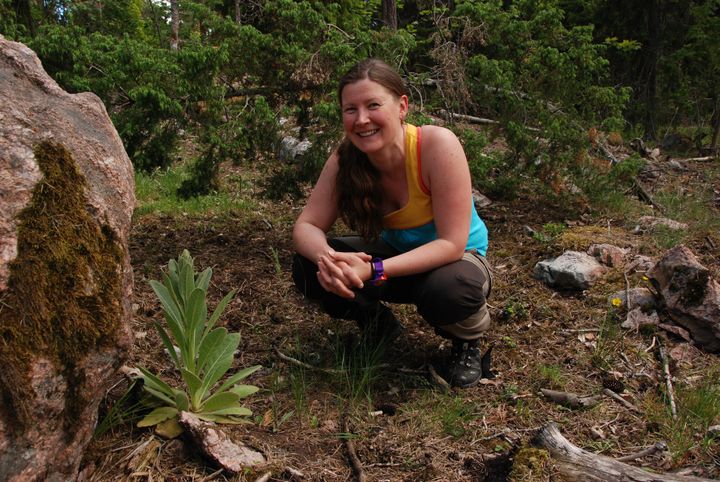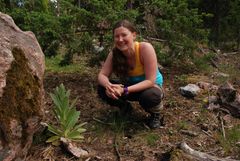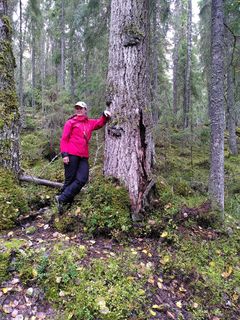Defense: Spatial conservation prioritization for the improvement of the national protected-area network
The thesis concerns identifying the most important areas from the biodiversity perspective in Finland. The studies include forest, mires, and the Natura 2000 network. Also, areas with the least value for biodiversity were recognized, which enables targeting actions that harm nature there. According to the results, there are significant differences between areas in terms of the biodiversity being supported. When the most important areas for biodiversity are known, conservation measures can be executed in a cost-effective manner. M. Sc. Ninni Mikkonen, who works at Syke, will defend the doctoral dissertation in the University of Helsinki, on 20 September 2024.

The benefits that are gained from nature conservation will be higher if nature conservation is executed on areas where biodiversity values are high. Correspondingly, actions that cause harm to biodiversity should be targeted to areas with the least biodiversity values.
“The importance of an area from a biodiversity perspective varies significantly between locations. This is one of the main results in my PhD thesis,” shares Ninni Mikkonen. “A high-conservation value biodiversity area cannot be restored as such, after it is destroyed. This is why targeting conservation measures should be carried out with concern about whether it is a forest, a mire, or any other habitat.”
The studies in this thesis are based on data and other information on nature which have been collected and gained over the course of decades for multiple purposes such as nature conservation or forestry.
High-conservation value areas in Southern Finland were searched for especially
The most important forests from a biodiversity perspective were identified. These forests are typically multispecies with trees of different age and size, dead and alive. Thus, they often contain more dead wood, an important biodiversity indicator, than managed forests. Also, they have not been fragmented by forest cuts but instead form a continuous forest cover in the landscape.
High-conservation value forest areas were found all around Finland, although the study method focused on finding them especially in Southern Finland. The reasoning for this was that in Southern Finland the human pressure on nature has been higher, which has promoted heavy biodiversity loss. This is the case especially within the most fertile forests, herb-rich forests, and fens, which have been turned into agricultural areas and forestry forests.
Complementary areas for mire conservation network were suggested
The most efficient addition to the present mire conservation network were identified. These are areas with rare mire habitat types that are missing or insufficiently represented in the existing network.
The identified high biodiversity mires were coupled with regional targets and expert knowledge which together created a proposition of approximately 100 000 hectares to a national mire-protected-area network. “In a bygone era, there was no political will to implement the protection of these areas but nowadays, these areas serve the needs of the regional planning and Helmi habitats program,” explains Ninni Mikkonen. Helmi aims to strengthen Finland’s biodiversity by, e.g., protecting and restoring mires.
Unique nature areas were identified
The most important Natura 2000 management landscapes that were identified in Mikkonen’s thesis were often unique entities such as small Vattajanniemi-Rahja in the Kokkola region with rare coastal and dune habitats or the large Kilpisjärvi region, which provides an aggregated and unfragmented continuum of high-quality environments varying from freshwater, to fell, peatlands, forests, and rocky habitats. Many others were also found; the Pori region with large and shallow bays and river deltas combined with coastal grasslands, the Hailuoto region with its multiple dune and coastal habitats, or Oulanka with calcareous lakes and ponds and various peatland, forest, and meadow areas.
”These management landscapes should be especially taken care of as there are no other places that could replace the nature values that occur there,” explains Ninni Mikkonen.
The studies also pointed out that there are four Natura 2000 habitats that only occur outside the most strictly protected areas, such as large shallow inlets and bays.
These results can be utilized to improve the protected-area network
All studies included in this thesis were commissioned for real need. The idea behind them has been to utilize them for improving Finland’s national protected-area network. This can be achieved by identifying areas 1) for allocating resources inside the present protected-area network, 2) for identifying the most efficient addition for permanent protection, or 3) for planning for nature management outside the conservation network. The methodologies developed in this thesis serve the needs of cost-effective execution of, e.g., the EU’s Nature Restoration Regulation and Regional Biodiversity Action Plans. In both, the ecological spatial data and analyses need to be combined with socio-ecological information.
Protecting old forests owned by the government would be cost-effective
”Protecting nature always has a monetary price. Instead of cutting the government-owned high-conservation value areas, such as such as old pristine forests, and using a significant amount of money for buying typically smaller fragments with possibly lower biodiversity quality, it would be a cost-effective use of the government’s conservation budget to first protect the high-conservation value areas on their own land. The same goes with any other habitats,” ponder Mikkonen.
“Nevertheless, as the Finnish government does not have large land properties in Southern Finland, this won’t help the biodiversity loss there,” Mikkonen reminds us. “Therefore, it is very important to have multiple options for nature protection in the future as well, just as METSO the Forest Biodiversity Programme for Southern Finland has been.
For more information
Ninni Mikkonen, M. Sc., coordinator, doctoral researcher, Finnish Environment Institute (Syke), firstnme.lastname@syke.fi, puh +358 295 251 890
Ninni Mikkonen, M. Sc. will defend the doctoral dissertation entitled "Spatial conservation prioritization for the improvement of the national protected-area network" in the Faculty of Science, University of Helsinki, on 20 September 2024 at 13:15. The public examination will take place at the following address: Biokeskus 2, sali 1041, Viikinkaari 5, Helsinki.
The examination can also be followed remotely
Academic dissertation: Spatial conservation prioritization for the improvement of the national protected-area network (helda.helsinki.fi)
Keywords
Contacts
Media service at Finnish Environment Institute
Our Media Service provides information on research, helps journalists find experts for interviews and provides photos for media use.
Our Communication experts will answer your inquiries on weekdays from 9 am to 4 pm.
Images
Finnish Environment Institute - We build hope through research.
Finnish Environment Institute
Latokartanonkaari 11
00790 Helsinki
+358 295 251 000
It is time to move beyond solving environmental problems one by one, to systemic sustainability transformations. The Finnish Environment Institute (Syke) contributes to building a sustainable society through research, information and services. The Finnish Environment Institute is a research institute with 700 experts and researchers located in Helsinki, Oulu, Jyväskylä and Joensuu.

Subscribe to releases from Suomen ympäristökeskus
Subscribe to all the latest releases from Suomen ympäristökeskus by registering your e-mail address below. You can unsubscribe at any time.
Latest releases from Suomen ympäristökeskus
Viikkokatsaus 28.4.–2.5.202524.4.2025 12:40:26 EEST | Tiedote
Hei! Tässä tiedoksesi meillä Suomen ympäristökeskuksessa ensi viikolla ilmestyviä tiedotteita, uutisia, kampanjoita, blogeja ja uutiskirjeitä. Mukana myös tulevia tapahtumia ja webinaareja. Jakelemme viikkokatsauksen torstaisin STT:n kautta. Koosteet löytyvät myös STT-uutishuoneesta, josta voit tilata kaikki Suomen ympäristökeskuksen tiedotteet.
Viikkokatsaus 22.–25.4.202517.4.2025 13:31:13 EEST | Tiedote
Hei! Tässä tiedoksesi meillä Suomen ympäristökeskuksessa ensi viikolla ilmestyviä tiedotteita, uutisia, kampanjoita, blogeja ja uutiskirjeitä. Mukana myös tulevia tapahtumia ja webinaareja. Jakelemme viikkokatsauksen torstaisin STT:n kautta. Koosteet löytyvät myös STT-uutishuoneesta, josta voit tilata kaikki Suomen ympäristökeskuksen tiedotteet.
Purkumateriaali- ja rakennusjäteselvityksen laadintaan saatavilla uusia ohjeita sekä purkumateriaalilaskuri16.4.2025 09:47:54 EEST | Tiedote
Tammikuussa käyttöönotetun purkumateriaalin ja rakennusjätteen selvitystietojärjestelmän (Rapu) kehitys jatkuu aktiivisena. Tietojärjestelmän käyttöön on nyt julkaistu täyttöohje ja selvityksen laatimista tukeva pienten rakennusten arviointiin tarkoitettu purkumateriaalien arviointilaskuri.
Ekologinen kompensaatio auttaa luontotavoitteiden saavuttamisessa mutta vaatii sitoutumista15.4.2025 12:15:22 EEST | Tiedote
Suomen ympäristökeskuksen ekologisen kompensaation pilotoinneista kokoamat havainnot osoittavat, että luontohaittojen hyvittäminen on mahdollista, mutta vaatii onnistuakseen strategista sitoutumista, olipa kyse yritysjohdosta tai kuntapäättäjistä.
Selvitys: Muovinkierrätyksen läpimurto edellyttää monipuolisia toimia ja selkeyttä julkiseen ohjaukseen15.4.2025 09:01:00 EEST | Uutinen
Tuoreen selvityksen mukaan muovinkierrätyksen läpimurto Suomessa vaatii vielä runsaasti toimenpiteitä ja niitä tukevaa julkisen vallan ohjausta, eivätkä esimerkiksi suunnitteilla olevat laitosinvestoinnit yksin riitä muovinkierrätysasteen merkittävään kohentumiseen. Nykyisin noin 80 prosenttia Suomessa syntyneestä kaikesta muovijätteestä päätyy energiahyödyntämiseen.
In our pressroom you can read all our latest releases, find our press contacts, images, documents and other relevant information about us.
Visit our pressroom


